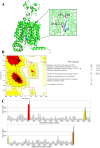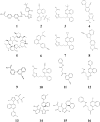Gout management: Patent analytics and computational drug design explores URAT1 inhibitors landscape
- PMID: 40802708
- PMCID: PMC12349300
- DOI: 10.1371/journal.pone.0328559
Gout management: Patent analytics and computational drug design explores URAT1 inhibitors landscape
Abstract
Gout, caused by hyperuricemia, has a detrimental impact on patients'quality of life. The urate transporter 1 (URAT1) stands out as a key therapeutic target. However, its clinical development remains uncertain. This study aims to explore the landscape of URAT1 inhibitors by combining global patent analytics with computational drug design. We utilized the Derwent Innovation platform to analyze patents (from 2005 to 2024). Molecular docking was performed on 73.96% of novel compounds using AutoDock Vina. Additionally, scaffold diversity was analyzed using the Bemis-Murcko (BM) scaffold approach. A total of 2,195 entries were screened and eventually narrowed down to 1,056 high-value entries. The global research on URAT1 inhibitors is highly active, with China, the US, Japan, and Europe leading. Most patents are new compounds, indicating significant potential for novel drug development. Molecular docking showed ideal binding affinities for most compounds. The top five BM scaffolds were identified and compared with marketed drugs. This study highlights the potential for developing new URAT1 inhibitors. The identified compounds and scaffolds offer promising starting points for further drug development. Future work should focus on experimental validation and exploring clinical potential.
Copyright: © 2025 Zhang et al. This is an open access article distributed under the terms of the Creative Commons Attribution License, which permits unrestricted use, distribution, and reproduction in any medium, provided the original author and source are credited.
Conflict of interest statement
The authors have declared that no competing interests exist.
Figures










Similar articles
-
Prescription of Controlled Substances: Benefits and Risks.2025 Jul 6. In: StatPearls [Internet]. Treasure Island (FL): StatPearls Publishing; 2025 Jan–. 2025 Jul 6. In: StatPearls [Internet]. Treasure Island (FL): StatPearls Publishing; 2025 Jan–. PMID: 30726003 Free Books & Documents.
-
Systemic treatments for metastatic cutaneous melanoma.Cochrane Database Syst Rev. 2018 Feb 6;2(2):CD011123. doi: 10.1002/14651858.CD011123.pub2. Cochrane Database Syst Rev. 2018. PMID: 29405038 Free PMC article.
-
The quantity, quality and findings of network meta-analyses evaluating the effectiveness of GLP-1 RAs for weight loss: a scoping review.Health Technol Assess. 2025 Jun 25:1-73. doi: 10.3310/SKHT8119. Online ahead of print. Health Technol Assess. 2025. PMID: 40580049 Free PMC article.
-
Antidepressants for pain management in adults with chronic pain: a network meta-analysis.Health Technol Assess. 2024 Oct;28(62):1-155. doi: 10.3310/MKRT2948. Health Technol Assess. 2024. PMID: 39367772 Free PMC article.
-
Exploring Type II Diabetes Inhibitors from Genus Daphne Plant-species: An Integrated Computational Study.Comb Chem High Throughput Screen. 2025;28(8):1413-1442. doi: 10.2174/0113862073262227231005074024. Comb Chem High Throughput Screen. 2025. PMID: 38584562
References
LinkOut - more resources
Full Text Sources

